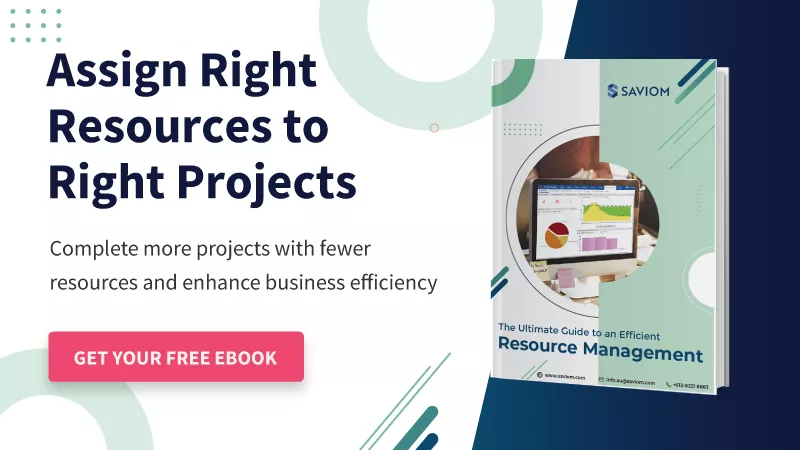Out of all the industries affected by the ongoing COVID-19 pandemic, the aerospace and defense sector took a major hit.
Forbes reports that international flights had a 68% drop in revenue and a 30% reduction in the overall production rate of commercial aircraft in 2020.
As the world is now recovering from the pandemic, the A&D industry is rebuilding itself by adopting ground-breaking technologies and solutions.
Undoubtedly, bringing these high-level projects to fruition demands a highly-specialized workforce and an effective resource management strategy.
Unfortunately, this industry is facing numerous resourcing bottlenecks, especially after the large-scale layoffs and high attrition during 2020.
It includes skill shortage, employee burnout, higher attrition, and more. Therefore, the A&D sector must adopt robust practices to mitigate these challenges and ensure the project’s success.
This article highlights some of these significant bottlenecks and effective ways to course-correct them.
First, let’s get some industry insights,
An overview of the aerospace and defense industry (A&D)
The Aerospace and Defense(A&D) industry is an umbrella term that covers different sectors involved in the designing, manufacturing, development, and sales of technologically advanced aircraft, space and defense systems. These sectors are:
- Commercial and general aviation aircraft
- Military aircraft
- Space systems
- Shipbuilding
- Ground defense
Now let’s look at the unique characteristics of the A&D industry.
Characteristics of the A&D sector
As discussed, the aerospace and defense (A&D) industry is involved in building ships, spacecraft, weapon systems, and defense equipment. They sell their products and supporting services to both governments and private companies. Moreover, since the cost of these systems is exceptionally high, leasing has become a common practice. As a result, organizations investing in them can upgrade their inventory from time to time and save long-term maintenance costs.
However, the production of aerospace and defense systems is a complex process. The project essentially has four stages- design, construction, assembly, and testing. Each stage is further divided into multiple steps, and it takes months to years to accomplish every one of them.
It is common to have a development cycle that lasts 10-15 years from concept to fielding. Additionally, the A&D personnel works with untested, next-generation technology as projects are often released after almost a decade. Hence, a clear understanding of the future is necessary to ensure that their finished product is valid when released.
Therefore, technological progress is the basis for the aerospace industry as it depends on sophisticated equipment for designing and manufacturing massive structures like space launchers, aircraft, etc.
However, certain external and internal factors influence this industry’s progress. For example, unforeseen political war will lead to a rise in the demand for defense systems. On the other hand, situations like the COVID-19 pandemic can minimize the need for civil aviation.
Given the technological dependence, the industry requires specialized employees like engineers and technicians with the right expertise to meet its requirements. Let’s take a look.
Roles in the aerospace and defense industry
- Aeronautical Engineers:
They design, develop, test, and help manufacture commercial and military aircraft, missiles, spacecraft, supersonic jets, helicopters, space shuttles, satellites, and rockets. Aeronautical engineers also have expertise in aerodynamics, propulsion, flight mechanics, and stability and control.
- Spacecraft Systems Engineer:
They are typically senior engineers with years of experience in the space industry who are a part of the spacecraft program life cycle. They have technical knowledge about the subsystems in a spacecraft, including the structural and electrical systems, thermal control, power, and communication.
- Aerospace Technicians:
They assist engineers in preparing equipment drawings, blueprints, and scale models and perform laboratory tests. Aerospace technicians test prototypes, analyze data and oversee the construction of new aircraft designs.
- Embedded Systems Engineers:
Embedded systems in the aerospace sector include temperature control, speed control, sensors, flight management systems, radar systems, and engine control. Embedded system engineers design, develop, test, and maintain these systems to eliminate potential issues.
- Avionics Engineer:
Avionics are electronics systems like engine controls, flight control systems, navigation, communications, threat detection, fuel systems, etc., in aircraft, artificial satellites, and spacecraft. Avionics engineers manufacture and test avionics systems, rectify faulty parts, and schedule maintenance and inspection.

Now that the roles in the aerospace and defense industry are clear, let’s look at some significant resource challenges and the strategies to mitigate them.
Resourcing challenges in the aerospace and defense industry and how to combat them
The (A&D) sector prioritizes attracting top talent because it relies on the most cutting-edge technologies and scientific expertise. Yet, numerous bottlenecks can hamper its projects.
Some of them are discussed below with their relevant solutions.
Lack of foresight into pipeline A&D projects
Given the complex nature of the A&D systems, companies need to plan their projects years in advance to ensure the availability of equipment and resources. For example, according to BBC, if a nuclear submarine is being developed, it will take 6-15 years to design and build and around $1.6bn to complete the project.
However, due to a lack of foresight in these projects, companies initiate last-minute firefighting for the right personnel, causing project delays, budget overruns, etc.
So, what is the suitable solution for this?
Solution- Foresee and bridge capacity vs. demand gap in advance.
Considering the example mentioned above, building a nuclear submarine will require expert personnel such as engineers, technicians, testers, etc. If the company does not meet the resource demand, they will need a lead time of at least 5-6 months to bridge the capacity vs. demand gap since they are hired for a long-term to accomplish the project.
Using the resource management software, managers can stay abreast of these requirements, get foresight into the capacity vs. demand gap, and proactively implement measures such as planned hiring, upskilling, or training to bridge it. Thus, it will give them enough leeway to allocate cost-effective resources and save last-minute firefighting costs, thus ensuring profitability.
Read More: What is Resource Capacity Planning? An Ultimate Guide for Every Project Manager
Inability to allocate cost-effective resources in the A&D sector
Since the A&D sector demands niche expertise, the charge-out or cost rate of resources is high. For instance, the average base salary for an aeronautical engineer in the US is around $101,762 per year. This will only increase when companies don’t have access to the global talent pool and hire experts from high-cost countries like the USA.
In addition, the lack of visibility into the enterprise-wide resource pool makes it challenging to identify cost-effective employees and allocate them.
So how do you combat these issues?
Solution: Identify and allocate competent aerospace resources
Aerospace and defense organizations need to invest in a resource management tool that will provide 360-degree visibility of A&D resources and their attributes such as skill set, competencies, cost, location, etc.
This will enable them to identify the best-fit resource and allocate resources from low-cost locations. Considering the above example, these countries will be Mexico, India, Philippines, etc.
Increased skills gap and shortage of aerospace resources
The increasing shortfall of technically skilled labor, such as aeronautical engineers, technicians, etc., is one of the significant challenges of the A&D industry. For one, not many are pursuing aerospace engineering or other related fields as their graduate specialization.
For two, the academic curriculum for the existing students is not updated according to the current trends. This makes them unprepared for their job since they lack the necessary skills and industry knowledge. In addition to this is the higher attrition of aerospace engineers.
How will you bridge this gap?
Solution- Facilitate training and upskilling programs for skill development
To mitigate the shortage of skilled labor, managers can use the resource management tool that provides visibility into the future skill demands and employees’ present competencies. This enables managers to assess the skills gap and develop training and upskilling programs as appropriate. This will future-ready the workforce and help them equip diverse skillsets and perform multiple roles.
In addition, if there is partial skill alignment, managers can also provide on-the-job training for the employees to help them gain more hands-on experience.
Read More: How Can Retraining/Upskilling Future-Proof Your Workforce?
High employee burnout decreases productivity
The overall talent shortage and skill gap often result in the overutilization of existing employees. For instance, in an aviation company, the constant testing of prototypes and other equipment is time-consuming, and often technicians have to work overtime to meet the deadlines.
However, studies show that unreasonable workload and excessive overtime are two leading contributors to employee burnout. When employees are stressed and burnout, it results in unplanned absenteeism and low productivity, affecting the project completion.
What can you do to prevent employee burnout?
Solution: Optimize A&D resource utilization levels
Maintaining the A&D employees’ health index will ascertain enhanced productivity and engagement. Managers can confirm this by tracking the utilization of aerospace resources in real-time. The utilization heatmap, and forecast vs. actual utilization reports, give accurate insights into A&D employees’ performance and productivity, allowing managers to take corrective measures ahead of time.
If they are overutilized, managers can pull in additional engineers or shift the project dates depending on the time sensitivity.
High attrition and early retirement rates of the aviation workforce
According to a study, 18 percent of all U.S. aerospace engineers and 24 percent of all aerospace manufacturing employees are eligible for retirement. With numerous employees retiring, there is a growing skill shortage in the industry. This has led to increased competition for competent aerospace and defense experts.
As a result, other companies offer high salary packages to attract employees, resulting in increased turnover rates. Moreover, the overutilization scenario mentioned earlier can also trigger unplanned attrition.
How can companies reduce attrition rates?
Solution- Monitor employee engagement and take measures to boost their morale
Organizations need to ensure that aerospace employees are regularly appreciated and recognized for their hard work to boost morale. In addition, providing opportunities to work on multifaceted projects must be given to employees to expand their potential. For instance, allowing an aeronautical engineer working in an aviation company also to gain exposure to designing helicopters will motivate them to push their limits.
When their careers are catered to, they will naturally associate with you for the long term, thus reducing turnover rates. Furthermore, succession planning must be implemented to identify future leaders who can fill the position within the company when senior staff retires.
Read More: 11 Effective Strategies to Enhance Employee Engagement
This article explores how to keep your employees engaged in today’s corporate scenario.
Ineffective aircraft equipment scheduling
Advanced technology and machinery are required at every stage of aircraft manufacturing. However, the lack of visibility into equipment scheduling results in shortages and double bookings of the necessary machinery. In addition, it delays task completion, resulting in project halts and, sometimes, failure.
On the other hand, if there is excess equipment, it remains unused for a long time and exhausts the maintenance budget.
How can managers mitigate this issue?
Solution- Facilitate effective aircraft equipment management
The A&D industry is highly dependent on equipment like press brakes, milling machines, CNC machines, etc. Manual management of these machines can be challenging, especially when multiple departments rely on the same ones.
Implementing an equipment scheduling solution will provide managers with complete visibility of the equipment schedule and prevent any unnecessary discrepancies such as double bookings. Moreover, the early warning system keeps managers forewarned of equipment nearing maintenance and service dates, avoiding damage.
Obsolescence of aerospace machinery
McKinsey estimates that the aggregate obsolescence-related nonrecurring costs for the military aircraft segment alone range from $50 billion to $70 billion.
Aerospace and defense companies develop advanced products with long lifecycles of 30 years or more, but the internal components like semiconductors, electronic boards, etc., have a much shorter life span. The challenge is to identify when to replace this equipment. It becomes harder to source these parts over time as suppliers either stop manufacturing them or the material to build them is no longer available.
Solution: Provides early warnings & alerts for aerospace equipment
As mentioned earlier, the equipment scheduling solution helps track the machinery’s lifecycle and provides early warning for the A&D equipment to be replaced. This allows organizations to find alternate suppliers and raw materials in advance if the manufacturing is stopped.
They also have adequate time to redesign and install the new components. This ascertains that upgraded, top-quality equipment is being used to manufacture high-grade defense systems.
Conclusion- Additional tips
It’s evident that the Aerospace and Defense industry is plagued with numerous resourcing bottlenecks. The above-mentioned corrective measures and advanced resource management software will help mitigate them. In addition, companies can also follow these additional tips to ensure smooth workforce management.
- Implement diversity, equity, and inclusion (DE&I) initiatives.
- Inspire and motivate the next generation to pursue a career in the A&D sector by highlighting the inherent appeal of the industry.
- Prioritize the recruitment of newer technical skills instead of traditional skills.
- Improve employee mentoring and coaching programs and keep them up to date with the latest trends.
- Facilitate reskilling, intensive research and development opportunities, and cross-functional rotations for employees.
- Collaborate with universities to include a current technology-based knowledge base in the academic curriculum
What resourcing challenges are you facing within your A&D organization?
The Glossary
Read More: Glossary of Resource Workforce Planning, Scheduling and Management
The SAVIOM Solution
SAVIOM is the market leader in offering the most powerful and configurable solutions for managing enterprise resources efficiently and effectively. Having more than 20 years of experience, this Australian-based MNC has a global presence in over 50 countries. It is also popular with more than 100 customers and helps them achieve their business goals. SAVIOM also has products for project portfolio management, professional service automation, and workforce planning software which can be easily customized as per business requirements.











